
by ENS Bryan Brasher, Safety Officer, NOAA Ship Okeanos Explorer
July 7, 2017
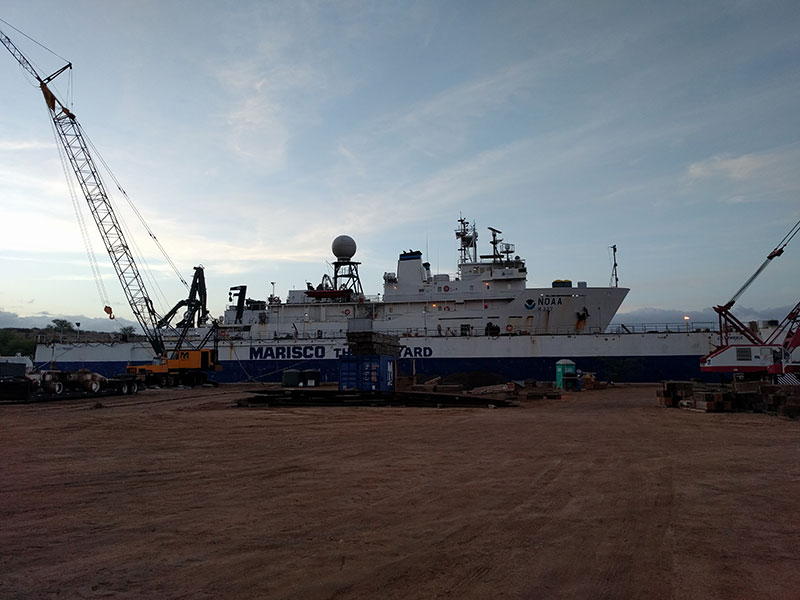
NOAA Ship Okeanos Explorer in dry dock at Barbers Point on the Island of O‘ahu in Hawaii. During dry dock, the ship underwent maintenance and repairs so that the ship is ready for our next expedition. Image courtesy of ENS Hallingstad, 2017 Laulima O Ka Moana. Download larger version (jpg, 4.5 MB).
On July 7, NOAA Ship Okeanos Explorer started the first part of the 2017 Laulima O Ka Moana expedition, beginning with four days of “shakedown” operations to run and test systems following dry dock repairs. Read below to learn more about what happened during the dry dock operations.
As NOAA Ship Okeanos Explorer pulled into Pearl Harbor, Hawaii, on May 19—ending our most recent mission in the Central Pacific Basin—the crew was already making preparations for dry dock. No less than 48 hours after arriving home, Okeanos Explorer sailed to the west coast of O‘ahu and docked at Barbers Point Harbor and immediately began scheduled maintenance. Four days later, the ship was lifted out of the water on the shipyard’s floating dry dock.
During dry dock, the ship is lifted out of the water to enable thorough ship maintenance and repair work, including work on areas of the ship that are often not accessible or safe to work on while the ship is in the water. Just like conducting routine maintenance on your car, these periodic repairs and improvements are critical to ensuring Okeanos Explorer can effectively support the science and engineering operations that allow exploration of the unknown ocean.
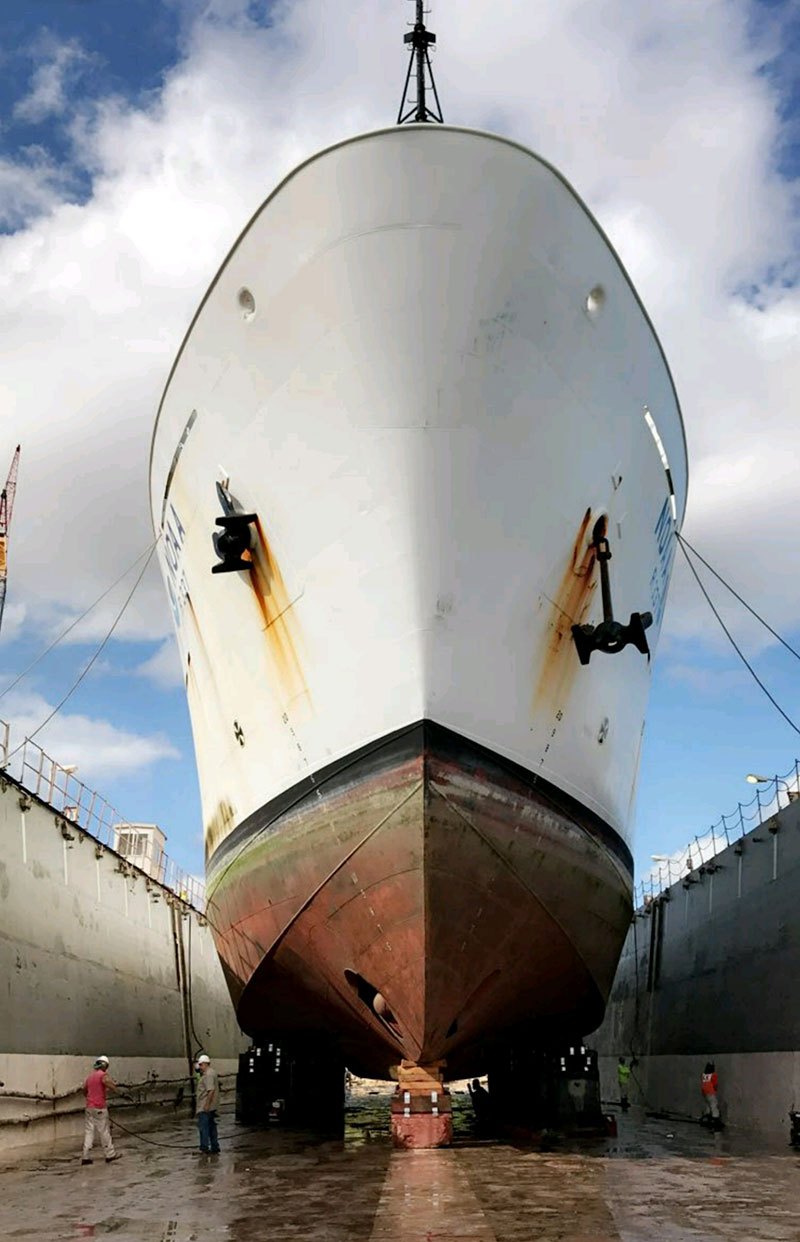
During dry dock, the Okeanos Explorer was raised out of the water so that maintenance crews and engineers could work on the hull of the ship. The hull of the ship was cleaned and painted, with crews taking care not to damage any underwater sensors mounted on the hull. These sensors help map the ocean and also help locate the remotely operated vehicles using transducers for underwater acoustic positioning. Image courtesy of ENS Hallingstad, 2017 Laulima O Ka Moana. Download larger version (jpg, 4.5 MB).
Life during dry dock is busy with its own unique challenges. There is no running water on the ship, shore-provided power is restricted, and ongoing repairs throughout the ship mean that crewmembers are unable to safely live aboard. For the entirety of the repair period, the ship effectively becomes an immobile construction site complete with offices, workshops, and an array of different, but concurrent, projects.
Every project is planned well in advance of the repair period. Although each of these projects require their own special personnel, parts, and logistical support, all dry dock work is governed by a variety of Occupational Safety and Health Administration (OSHA) and industry-developed health and safety standards to ensure the highest levels of safety during maintenance and repairs. Significant work goes into understanding, scrutinizing and mitigating any potential hazards or safety concerns that could arise during dry dock activities. This includes daily testing of confined spaces for unsafe gases by a certified chemist, evaluating work spaces for potential fire hazards, checking all emergency equipment to ensure it has been recently serviced, and verifying that all involved workers have the appropriate credentials to safely conduct the work or mitigate any potential problems.
With the Dry Dock Specification for repairs and modifications to Okeanos Explorer (and its associated references and appendices) reaching into the hundreds of pages, it is not possible to briefly detail each and every project. It is possible, however, to mention some of the larger, understandable, and/or noticeable projects that were completed prior to getting underway in July.
Common among any ship is the accumulation of microorganisms, plants, and algae on all wet surfaces. This accumulation, also referred to as biofouling, can have direct impacts on the performance of the vessel and therefore its mission. This accumulation on the hull, rudders, thrusters, and propellers can increase both the hydrodynamic volume and friction of the vessel. This increased drag reduces the maximum speed of the vessel and of the efficiency of the vessel to maintain position. Although equipped with both active (e.g., electric pulses in the sea chest) and passive (e.g., non-toxic anti-stick coatings) anti-fouling equipment, Okeanos Explorer inevitably experiences various levels of biologic growth.
While out of the water, the hull, with special attention to the vital sonar transducers, is cleaned of all foreign material. The hull is sand blasted, cleaned, and painted. The main propellers and the propellers on the bow and stern thrusters were also renewed with their respective shaft seals being replaced. Besides these surfaces and interfaces below the waterline being rehabilitated, significant portions of the decks were stripped, cleaned, and repainted.
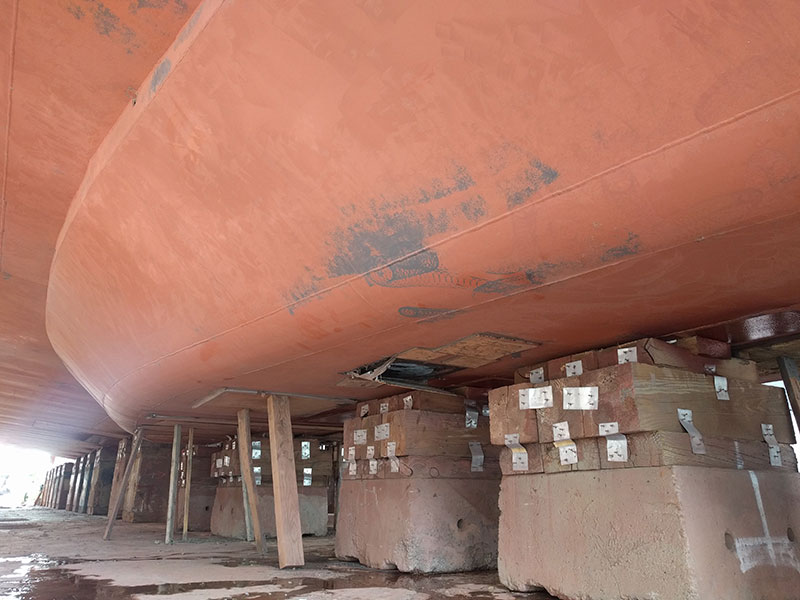
The transducer fairing houses the ship’s various acoustic systems, including the transducers for the multibeam sonar (mapping), echo sounder, fathometer, Acoustic Doppler Current Profiler, scientific sounding system (water column profiler), and ultra short baseline acoustics (system to track position of the remotely operated vehicle). Image courtesy of ENS Hallingstad, 2017 Laulima O Ka Moana. Download larger version (jpg, 4.6 MB).
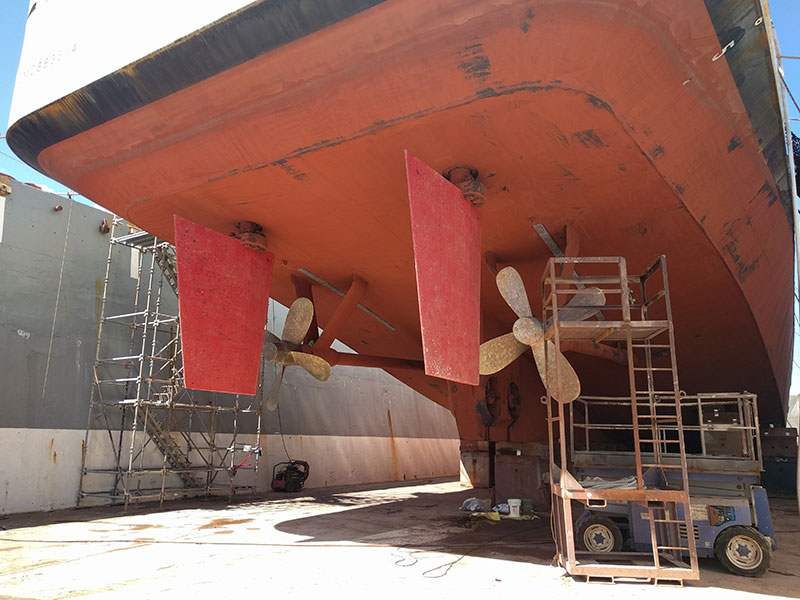
The Okeanos Explorer has two large rudders that steer the ship while underway. These rudders turn together in the same direction and are controlled by two steering pumps. The steering pumps receive input from the bridge through a controller and turn the rudders accordingly. The controller unit received calibration to ensure that the proper rudder angle is used. Image courtesy of ENS Hallingstad, 2017 Laulima O Ka Moana. Download larger version (jpg, 4.5 MB).
The hull is the watertight body of the ship and is composed of a complex configuration of bulkheads and intermediary supporting structures that enclose various watertight compartments that can be dry or filled with ballast or fuel. In May 2016, while Okeanos Explorer was conducting exploration operations in the Marianas Trench Marine National Monument, a small defect was found in the shell plating on the bottom of the ship beneath the main generator room. The defect was temporarily fixed by patching the immediate area from both inside and outside the ship. A physical patch was molded and placed above the affected area within a void in the vessel, and on the outside, divers welded a large doubler plate to cover the affected area. During our recent dry dock, the temporary fix was removed, and a large portion of the hull structure was cut and replaced to provide permanent repair.
Okeanos Explorer’s propulsion system is a diesel-electric drive whereby four ship service diesel generators (SSDGs) supply AC power that is rectified and used to energize two DC electric motors that turn the main propeller shafts. These four generators also produce the electricity that is used to run the thrusters as well as power all other aspects of the vessel. These large 600 kW Caterpillar D398 generators are turbocharged V12 four-stroke cycle engines and require regular maintenance. As with any large piece of machinery, these generators have scheduled periods of preventative maintenance and servicing.
During this dry dock period, two of the ship’s generators underwent a 40,000-hour overhaul. In short, the generators were completely disassembled to the smallest constituent parts with nearly every component being replaced or inspected and checked for allowable tolerances. Then—like a large, complex, and oily puzzle—they were reassembled and tested against manufacturer specifications for performance.
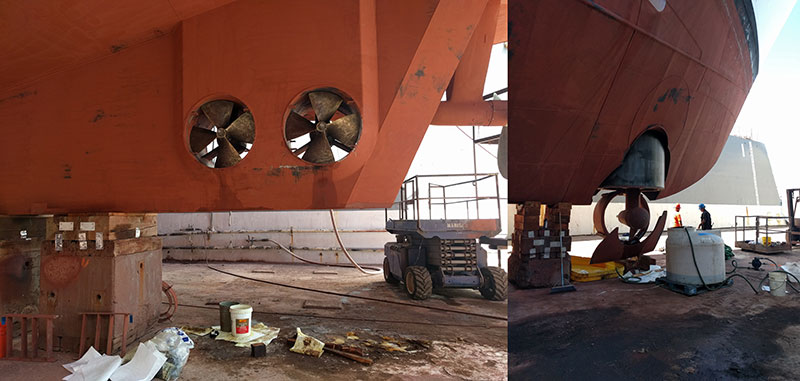
Also during the dry dock period, the bow thruster and stern thrusters underwent routine maintenance. The bow thruster is 550 HP and the stern thrusters have a combined HP of 500. These thrusters help maintain the ship’s position during remotely operated vehicle operations. Image courtesy of ENS Hallingstad, 2017 Laulima O Ka Moana. Download larger version (jpg, 8.1 MB).
In an effort to maximize the ability of the ship to support ocean exploration efforts, the repair period also included a number of upgrades to the ship’s bridge, navigational, and dynamic positioning (DP) systems. These include upgrades to the ship’s uninterruptible power supply to vital bridge electronics in the event of power loss. Redundancy is being added to the DP system to provide a safer operating margin if an issue were to arise in the system’s control network. Furthermore, the ship’s ability to precisely determine its location is being improved with the addition of two more global navigation satellite system (GNSS) receivers. Besides their superior accuracy, these new receivers add a level of diversity to the ship’s navigational suite that makes it easier to identify faults in any one input.
Alongside the aforementioned repairs and modifications are numerous other preventative maintenance checks, servicing, and upkeep on nearly every shipboard system including fuel, sewage, electrical, steering, thruster, and main propulsion system. These repairs ensure we can safely keep the ship afloat, the crew safe, and the mission moving forward.
As the ship prepares for its mission to the Johnston Atoll Unit of the Pacific Remote Islands Marine National Monument, now known as Pacific Islands Heritage Marine National Monument, the crew takes pride in knowing that the many long days, late nights, and weekends spent working have not been in vain.
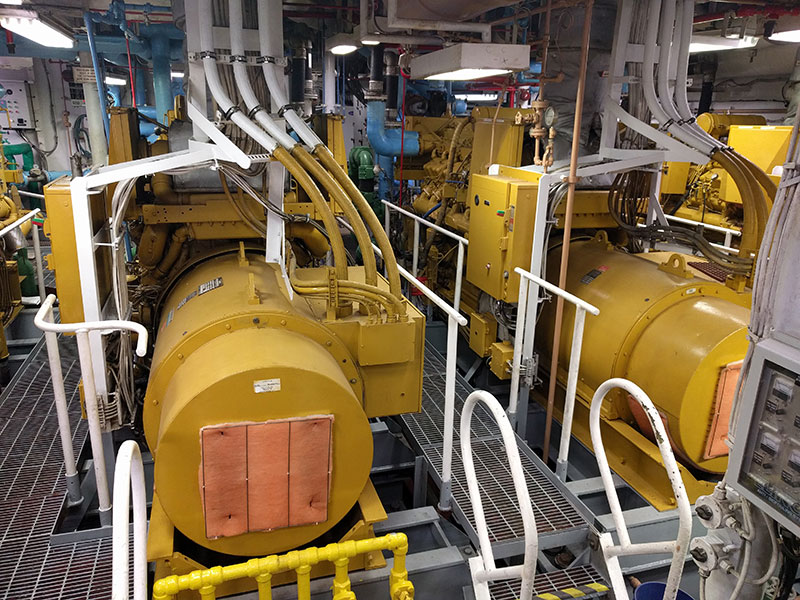
The Okeanos Explorer is diesel electric, using four very large diesel engines that put out 600 kilowatts of electricity each. This electricity is used to power the ship and the two main propulsion motors that turn the props moving the ship through the water at speeds of up to 10 knots. Two of these diesel engines are received their 40,000-hour overhaul during dry dock. Image courtesy of ENS Hallingstad, 2017 Laulima O Ka Moana. Download larger version (jpg, 6.2 MB).